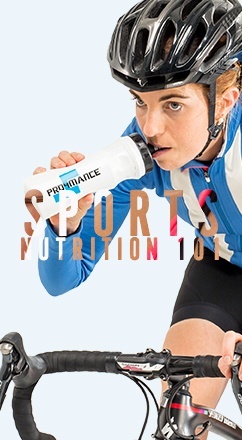Why does Produrance contain glucose and fructose?
A single carbohydrate ingested during exercise will be oxidized at rates up to 1g/min, even when large amounts of carbohydrates are ingested. Combinations of carbohydrates (e.g. glucose and fructose) have been shown to result in higher oxidation rates, which is a way to increase exogenous carbohydrate oxidation rates by 50% (Jeukendrup, 2004). This is attributed to the separate transport mechanisms across the intestinal wall for glucose and fructose. Glucose is transported across the luminal membrane by a glucose transporter called sodium dependent glucose transporters 1 (SGLT1). Fructose is transported by glucose transporter 5 (GLUT5) (Shi et al., 1995).
Wallis et al. (2005) achieved a rate of absorption/oxidation of carbohydrate of 1.5g/min with a drink consisting of 7.5% maltodextrins and 3.75% fructose (total carbohydrate 11.25%). The addition of 20 mm NaCl to this drink increased the rate of water absorption and the rate of carbohydrate absorption.
Jentjens et al. (2003) using 14C-labeled glucose and 13C-labeled fructose demonstrated that, with the ingestion of glucose and fructose the total exogenous carbohydrate oxidation rates were 55% higher compared with glucose only. Higher exogenous carbohydrate oxidation rates were also observed when glucose and sucrose were ingested in combination.
Evidence suggests that exogenous carbohydrate oxidation is limited by the rate of digestion, absorption, and subsequent transport of glucose into the systemic circulation rather than by the rate of uptake from the blood and subsequent oxidation by the muscle. This means if you are able to digest, absorb and transport large quantities of carbohydrates then the muscles will be able to convert them into energy while sparing liver glycogen to maximise your endurance nutrition.
Why does Produrance have a 2:1 ratio of glucose:fructose?
Combinations of carbohydrates (e.g. glucose and fructose) have been shown to result in higher oxidation rates, which is a way to increase exogenous carbohydrate oxidation rates by 50% (Jeukendrup, 2004). Glucose is found to be oxidized at relatively high rates (up to 1g/min). This implies that athletes can absorb 60g/h of glucose (Jeukendrup & Jentjens, 2000). Adding an additional 30g of fructose allows an athlete to absorb 90g/h making a 2:1 ratio of glucose:fructose which will maximise their endurance nutrition (Wallis et al., 2005).
What are the benefits of phosphorus (phosphate)?
Phosphorus is intimately involved in a number of metabolic pathways. Phosphate is the major anion of intracellular fluids and the proportion of intracellular phosphate available for energy metabolism depends upon the extracellular concentration (Brazy & Mandel, 1986).
Intracellular phosphate is involved in the regulation of energy metabolism and endurance performance in a number of ways:
(1) Increases the rate of ATP production
(2) Increases mitochondrion-enzyme activity
(3) Increases Creatine Phosphate resynthesis process
(4) Enhances Acid-Base balance during exercise
(5) Increases cardiac muscle contractility-response to exercise
(6) Stimulates glycolysis and energy metabolism
What are the benefits of sodium in endurance nutrition?
It is recommended that sodium (23-69 mg/100mL, 10-30mmol/L) be included in fluids ingested during exercise, especially when it is prolonged (longer than 1 hour) (ACSM et al., 2007; ADA et al., 2009). When exercise is performed for several hours, or when large amounts of sodium are lost in sweat, it is especially important for athletes to include sodium in fluid replacement drinks to minimize hyponatremia (Hopkins & Wood, 2006). The addition of sodium improves taste while also stimulating the osmotically dependent dipsogenic factors (thirst) that increases voluntary drinking, thus minimizing involuntary dehydration (Wemple et al., 1997). Absorption of fluids that enter the intestines is more rapid when sodium is present. Water uptake in the small intestine will help to maintain extracellular fluid volume and aid carbohydrate absorption (Schedl et al., 1994).
What are the benefits of magnesium?
Magnesium is involved in adenosine triphosphate (ATP) production from fatty acid oxidation, postcontractile muscular relaxation, and bone remineralization. It is also involved in phosphatidylglycerol (DPG) production, which is important to red blood cell formation. ATP, present in all cells but particularly in muscle cells, stores energy and must be bound to a magnesium ion in order to be biologically active. Low magnesium levels can acutely contribute to early fatigue, nausea and muscle cramps (Altura et al., 1996). Athletes lose magnesium through sweat, usually at a rate of, 0.8mmol /L (range 0.2-1.5mmol /L) (Sawka & Montain, 2000; Criswell et al., 1992).
What are the benefits of potassium?
Potassium is present in intracellular fluid and is responsible for regulating total cell water and stabilizing controlled/automatic muscle contractions. It is lost through sweat and urine at a rate of 5mmol/L (range 3-15mmol/L) (Sawka & Montain, 2000; Criswell et al., 1992). During exercise, cells lose potassium during muscle contractions which eventually increase serum levels instigating fatigue. Potassium intake during exercise increases markers of recovery, via muscle cell hydration and prevents intracellular dehydration (Tarnopolsky et al., 1996). Potassium aids the transport of glucose into the muscle cell and assists in the conduction of nerve impulses. Symptoms of potassium depletion include irregular heartbeat, slower reflexes, nausea, drowsiness, and muscle weakness and fatigue (Knochel, 1977).
Why doesn’t Produrance contain long-chain triglycerides (LCT) and medium-chain triglycerides (MCT)?
Despite extensive study, most investigators (Jeukendrup et al., 1995, 1996, 1998; Angus et al., 2000: Horowitz et al., 2000) have found medium-chain triglycerides (MCT) do not alter muscle glycogen during exercise consequently providing no benefit to exercise performance. It would appear that ingestion of sufficiently large doses of MCT cause gastrointestinal distress (Jeukendrup et al., 1996). Another factor influencing carbohydrate absorption is the consumption of triglycerides composed of predominantly long-chain fatty acids (LCT) (12-18 carbons) which significantly delay gastric emptying. This affects the rapidity of fat availability negatively and also slows fluid and carbohydrate replenishment, both crucial factors in high intensity endurance exercise. Consequently, the relatively slow rate of gastric emptying and subsequent digestion, absorption, and assimilation of LCT makes this energy source an undesirable supplement to augment energy metabolism (Emken, 1994).
Furthermore, when MCT are consumed with a carbohydrate feeding, the carbohydrate-stimulated insulin secretion partially inhibits the mobilization of the body’s own fat stores, resulting in large reductions in fat oxidation compared to exercise when fasted (Jeukendrup et al., 1995). Considering the amount of triglycerides stored in the body (Adipocytes – 5600g-6600g or 50,000 -60,000 kcals of energy and Intramuscular – 220g-330g or 2,000 to 3,000 kcals of energy) (Manore & Thompson, 2000), the addition of triglycerides in Produrance would have no significant advantage to exercise performance.
What is the recommended water consumption with Produrance?
The American College of Sports Medicine recommends that: ‘During exercise, athletes should start drinking early and at regular intervals in an attempt to consume fluids at a rate sufficient to replace all the water lost through sweating, or consume the maximal amount that can be tolerated’. Individuals should be encouraged to consume the maximal amount of fluids during exercise that can be tolerated without gastrointestinal discomfort (Convertino et al., 1996). Athletes are thus advised to replace all the water lost through sweating (loss of body weight), or consume the maximal amount that can be tolerated, or drink 600-1000 ml per hour (Noakes, 2003). For this reason Produrance is recommended to be mixed with 800ml (600-1000ml) of water depending on the athlete’s tolerance and taste preference.
Why do some Produrance Energy Gels contain caffeine?
Caffeine has been shown to be an effective ergogenic aid in endurance nutrition, improving power output, especially during the later stages of endurance performance (Graham, 1995; Wiles et al., 2006). Research suggests that 150 to 250 mg of ingested caffeine improves exercise performance (Anselme et al., 1992). Caffeine increases fat oxidation, sparing endogenous carbohydrate stores and thus improving performance especially in exercise where carbohydrate availability limits performance. Caffeine also directly effects the sympathetic nervous system, leading to a stimulatory effect on the neural signals between brain and neuromuscular junction which reduce fatigue, improve concentration, and enhance mental alertness (Graham, 2001). Athletes who drink caffeinated drinks regularly, however, appear to experience less ergogenic benefits from caffeine (Tarnopolsky et al., 1989).



